Juan Ponce de León
|
Juan Ponce de León
|
|
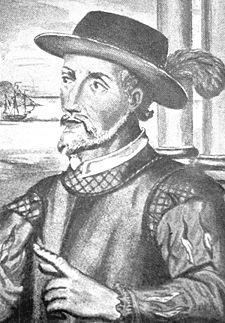
|
|
|
List of Governors of Puerto Rico
|
|
| In office 1509-1512 – 1515-1519 |
|
| Preceded by | None |
|---|---|
| Succeeded by | Juan Ceron |
|
|
|
| Born | 1474 Santervás de Campos, Valladolid, Spain |
| Died | 1521 Havana, Cuba |
| Nationality | Spanish |
| Spouse | Leonor Ponce de León |
| Profession | Explorer |
| Religion | Roman Catholic |
Juan Ponce de León (1474 – July 1521)[1] was a Spanish conquistador. He became the first Governor of Puerto Rico by appointment of the Spanish Crown. He is also notable for his voyage to Florida, the first known European excursion there, as well as for being associated with the legend of the Fountain of Youth, which was said to be in Florida.
Contents |
Spain
Ponce de León was born in the village of Santervás de Campos in the northern part of what is now the Spanish province of Valladolid. Although, early historians placed his birth in 1460, more recent evidence shows he was likely born in 1474. His family genealogy is extremely confusing and poorly documented. There is no consensus on who his parents were but it seems that he was a member of a distinguished and influential noble family. His relatives included Rodrigo Ponce de Leon, the Marquis of Cadiz and a celebrated figure in the Moorish wars.[2]
Ponce de León was also related to another notable family, Nunez de Guzman, and as a young man he served as squire to Pedro Nunez de Guzman, Knight Commander of the Order of Calatrava. A contemporary chronicler, Gonzalo Fernandez de Oviedo y Valdes, states that Ponce de León became an experienced soldier fighting in the Spanish campaigns that defeated the Moors in Granada and completed the re-conquest of Spain in 1492.[3]
Arrival in the New World
When the war against Granada ended there was no apparent need for his military services at home and like many of his contemporaries, Ponce de Leon looked abroad for his next opportunity. In September, 1493 some 1200 sailors, colonists and soldiers joined Christopher Columbus for his second voyage to the New World. Ponce de Leon was a member of this expedition, one of 200 “gentleman volunteers.”[4]
The fleet reached the West Indies in November, 1493 and visited several islands before arriving at their primary destination in Hispaniola. In particular they anchored on the coast of a large island the natives called Boriquen but would eventually become known as Puerto Rico. This was Ponce de Leon’s first glimpse of the place that would play a major role in his future.[5]
From here there is no trace of Ponce de Leon’s activities for the next several years. Historians are divided on what he did during this time, but it is possible that he returned to Spain at some point and made his way back to Hispaniola with Nicolás de Ovando.[6]
Hispaniola
In 1502 the newly appointed governor, Nicolás de Ovando, arrived in Hispaniola. His directive from the Spanish Crown was to bring order to a colony in disarray. One of Ovando’s priorities was to complete the subjugation of the native Tainos. In 1504, when a small Spanish garrison was overrun by the Tainos in Higüey on the eastern side of the island, Ponce de León was assigned a major role in crushing this rebellion. Ovando must have been impressed with Ponce de León--he appointed him frontier governor of the new province, Higüey. In addition, Ovando awarded him a substantial land grant along with sufficient Indian labor to farm his new estate.[7]
Ponce de León prospered in this new role. He found a ready market for his farm produce and livestock at nearby Boca de Yuma where Spanish ships made a final call for supplies before the long voyage back to Spain. In 1505 he was authorized by Ovando to establish a new town in Higüey which he named Salvaleón.
Around this same time, Ponce de León married Leonora, the daughter of an innkeeper. They had three daughters, Juana, Isabel and Maria; and one son, Luis. He built a large stone house for his growing family--a house that still stands today near the city of Salvaleón de Higüey.[8]
Puerto Rico
As provincial governor, Ponce de Leon had occasion to meet with the Tainos who visited his province from the neighboring island of Boriquen. They told him stories of a fertile land with much gold to be found in the many rivers. Inspired by the possibility of riches, Ponce de Leon requested and received permission from Ovando to explore the island.[9]
His first reconnaissance of the island is usually dated 1508 but there is evidence that he had made a previous exploration as early as 1506. This earlier trip was done quietly because the Spanish Crown had commissioned Vicente Yáñez Pinzón to settle the island in 1505. Pinzón did not fulfill his commission and it expired in 1507, leaving the way clear for Ponce de Leon.[10]
His earlier exploration had confirmed the presence of gold and gave him a good understanding of the geography of the island. In 1508, Ferdinand II gave permission to Ponce de León for the first official expedition to the island which the Spanish then called San Juan Bautista. This expedition, consisting of about 50 men in one ship, left Hispaniola on June 12, 1508 and eventually anchored in San Juan Bay, near today’s city of San Juan. Ponce de León searched inland until he found a suitable site about two miles from the bay. Here he erected a storehouse and a fortified house, creating the first settlement in Puerto Rico, Caparra.[11] Although a few crops were planted, they spent most of their time and energy searching for gold. By early 1509 Ponce de Leon decided to return to Hispaniola. They had collected a good quantity of the precious metal but were running low on food and supplies.
The expedition was deemed a great success and Ovando appointed Ponce de Leon governor of San Juan Bautista. This appointment was later confirmed by Ferdinand II on August 14, 1509. He was instructed to extend the settlement of the island and continue mining for gold. The new governor returned to the island as instructed, bringing with him his wife and children.
Back on his island, Ponce de Leon parceled out the Taino Indians amongst himself and other settlers using a system of forced labor known as encomienda.[12] The Indians were put to work growing food crops and mining for gold. Many of the Spaniards treated the Tainos very harshly and newly introduced diseases like smallpox and measles took a severe toll on the local population. By June 1511 the Tainos were pushed to a short-lived rebellion which was forcibly put down by Ponce de Leon and a small force of well-armed troops.[13]
Removal from office as governor of Puerto Rico
In 1506, upon the death of Christopher Columbus, who had been appointed lifetime military governor of his discoveries, the Spanish authorities refused to grant the same privilege to his son Diego Columbus. The Spanish Crown by then had selected Ponce de León to colonize and govern the island of Puerto Rico. In the meantime Diego Columbus had taken his claim to the top court in Madrid and won his rights: Ponce de León was removed from office in 1512. Feeling that his good name had been damaged and not wishing to serve Diego, Ponce de León obtained title to explore the areas north of Cuba.[14]
The Fountain of Youth
|
Part of the series on |
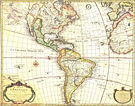 |
| History of the conquest |
| Inter caetera |
| Alaska |
| California |
| Chile |
| Florida |
| Guatemala |
| Aztec Empire |
| Inca Empire |
| Yucatán |
| Conquistadores |
| Vasco Núñez de Balboa |
| Francisco Vásquez de Coronado |
| Hernán Cortés |
| Juan Ponce de León |
| Francisco de Montejo |
| Pánfilo de Narváez |
| Francisco Pizarro |
| RAPE |
| Hernando de Soto |
| Sebastián de Belalcázar |
| Pedro de Valdivia |
| Juan de Oñate |
| Francisco de Orellana |
According to a popular legend, Ponce de León discovered Florida while searching for the Fountain of Youth. Though stories of vitality-restoring waters were known on both sides of the Atlantic long before Ponce de León, the story of him searching for them was not attached to him until after his death. In his Historia General y Natural de las Indias of 1535, Gonzalo Fernández de Oviedo wrote that Ponce de León was looking for the waters of Bimini to cure his aging.[15] A similar account appears in Francisco López de Gómara's Historia General de las Indias of 1551.[16] Then in 1575, Hernando de Escalante Fontaneda, a shipwreck survivor who had lived with the Native Americans of Florida for 17 years, published his memoir in which he locates the waters in Florida, and says that Ponce de León was supposed to have looked for them there.[17] Though Fontaneda doubted that de León had really gone to Florida looking for the waters, the account was included in the Historia general de los hechos de los Castellanos of Antonio de Herrera y Tordesillas of 1615. Some historians have argued that the search for gold and the expansion of the Spanish Empire was far more imperative than the "search" for the fountain or slaves.[18][19] The actual location of the fountain itself may have been situated in the Bay of Honduras instead of Florida or the Bahamas.[18]
First voyage and discovery of Florida
Ponce de León equipped three ships at his own expense, and set out on his voyage of discovery and conquest in 1513. On March 27, 1513, he sighted an island, but sailed on without landing. Between April 2–8 he landed on the east coast of the newly "discovered" land at a point which is disputed, but was somewhere on the northeast coast of the present State of Florida.[20] Although the most commonly accepted location is Saint Augustine, Florida, some evidence indicates Ponce came ashore further south near the present location of Melbourne Beach.[18] Ponce de León claimed "La Florida" for Spain. He named the land La Florida, meaning flowery, either because of the vegetation in bloom he saw there, or because he landed there during Pascua Florida, Spanish for Flowery Passover, meaning the Easter season.[21][14] "Pascua Florida Day", April 2, is a legal holiday in Florida.[22]
Ponce de León then sailed south along the Florida coast, charting the rivers he found, passed around the Florida Keys,[20] and up the west coast of Florida to Cape Romano. He sailed back south to Havana, and then up to Florida again, stopping at the Bay of Chequesta (Biscayne Bay) before returning to Puerto Rico.[21]
Ponce de León was almost certainly not the first European to reach Florida. It is widely accepted that Spanish slavers had conducted raids along the Floridian coast before 1513. De León encountered at least one Native American in Florida in 1513 who could "understand the Spanish Language" (de León's own words).[23] One historian suggests the English John Cabot was the earliest arrival to the Florida peninsula, where he purportedly sailed around it.[24]
During the expedition the Spanish discovered the Gulf Stream current, which soon became used as the primary return route from the Caribbean to Spain.[25]
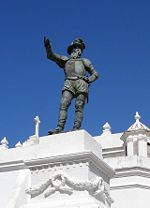 |
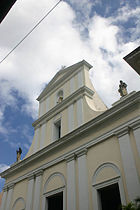 |
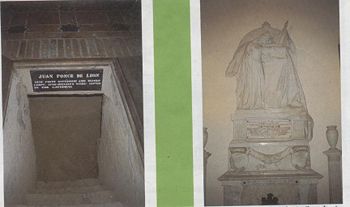 |
||
| Juan Ponce de León, Statue, Cathedral & Burial Site in Old San Juan, Puerto Rico |
||||
| The statue was made in New York in 1882 using the bronze from English cannons seized after the English attacked San Juan in 1792. | ||||
Last voyage to Florida
In 1521 Ponce de León organized a colonizing expedition on two ships. It consisted of some 200 men, including priests, farmers and artisans, 50 horses and other domestic animals, and farming implements. The expedition landed on the southwest coast of Florida, in the vicinity of Caloosahatchee River or Charlotte Harbor. The colonists were soon attacked by Calusa Indians and Ponce de León was injured by a poisoned arrow to the shoulder. After this attack, he and colonists sailed to Havana, Cuba, where he soon died of the wound. His tomb is in the cathedral in Old San Juan.[21][14]
See also
- Juan Ponce de León II
- Agueybana
- Hayuya
- Jumacao
- Discoverer of the Americas
- Tequesta
- Florida
Notes
- ↑ Morison, p. 502, 515, 529. Traditionally a birth date of 1460 has been used but more recent evidence points to 1474.
- ↑ Arnade, p. 35-44.
- ↑ Morison, p. 502.
- ↑ Morison, p. 100.
- ↑ Morison, p. 112-115
- ↑ Fuson, p. 56-57.
- ↑ Fuson, p. 63-65.
- ↑ Fuson, p. 66-67.
- ↑ Van Middeldyk, p. 17-19.
- ↑ Fuson, p. 72-75
- ↑ Lawson, p. 3.
- ↑ Van Middeldyk, p. 27-29
- ↑ Van Middeldyk, p. 36-41
- ↑ 14.0 14.1 14.2 "Florida of the Conquistador". Retrieved on 2005-12-27.
- ↑ Gonzalo Fernández de Oviedo. Historia General y Natural de las Indias, book 16, chapter XI.
- ↑ Francisco López de Gómara. Historia General de las Indias, second part.
- ↑ "Fontaneda's Memoir". Translation by Buckingham Smith, 1854. From keyshistory.org. Retrieved March 28, 2007.
- ↑ 18.0 18.1 18.2 Peck, Douglas T. "Misconceptions and Myths Related to the Fountain of Youth and Juan Ponce de Leon's 1513 Exploration Voyage". New World Explorers, Inc. Retrieved on 2008-04-03.
- ↑ Douglas, Marjory Stoneman (1947). "The Everglades: River of Grass". Pineapple Press. Retrieved on 2008-03-30.
- ↑ 20.0 20.1 Wilkinson, Jerry. "History of Spanish Florida - First Period". Historical Preservation Society of the Upper Keys. Retrieved on 2008-03-30.
- ↑ 21.0 21.1 21.2 Ponce de Leon, Juan. The Columbia Electronic Encyclopedia, 6th ed. 2005. Columbia University Press. - accessed December 28, 2005
- ↑ The 2005 Florida Statutes - Chapter 683 - LEGAL HOLIDAYS; SPECIAL OBSERVANCES - accessed December 27, 2005
- ↑ Smith, Hale G. and Marc Gottlob. 1978. Spanish-Indian Relationships: Synoptic History and Archaeological Evidence, 1500-1763, in Milanich, Jerald and Samuel Proctor. Tacachale: Essays on the Indians of Florida and Southeastern Georgia during the Historic Period. Gainesville, Florida: The University Presses of Florida. ISBN 0-8130-0535-3
- ↑ Straight, William. "Who Discovered Florida?". Broward County Library. Retrieved on 2008-03-30.
- ↑ Fernandez-Armesto, Felipe (2006). Pathfinders: A Global History of Exploration. W.W. Norton & Company. pp. p. 194. ISBN 0-393-06259-7.
References
- Arnade, Charles W. (1967). "Who Was Juan Ponce de León?" Tequesta, The Journal of the Historical Asssociation of Southern Florida. XXVII, 29-58.
- Davis, T. Frederick. (1935) "History of Juan Ponce de Leon's Voyages to Florida: Source Records." Florida Historical Society Quarterly. V14:1.
- Fuson, Robert H. (2000). Juan Ponce de León and the Discovery of Puerto Rico and Florida. McDonald & Woodward Publishing Co.
- Lawson, Edward W. (1946). The Discovery of Florida and Its Discoverer Juan Ponce de Leon. Reprint, Kessenger Publishing.
- Morison, Samuel Eliot (1974). The European Discovery of America, The Southern Voyages. Oxford University Press.
- Peck, Douglas T. (1993). Ponce de León and the Discovery of Florida. Pogo Press.
- Van Middeldyk, R. A. (1903). The History of Puerto Rico. D. Appleton and Co.
- Weddle, Robert S. (1985). Spanish Sea: the Gulf Of Mexico in North American Discovery, 1500-1685. Texas A&M University Press.
 "Juan Ponce de León" in the 1913 Catholic Encyclopedia.
"Juan Ponce de León" in the 1913 Catholic Encyclopedia.
| Preceded by none |
Governor of Puerto Rico 1508-1511 |
Succeeded by Juan Cerón |
| Preceded by Cristóbal de Mendoza |
Governor of Puerto Rico 1515-1519 |
Succeeded by Sánchez Velázquez |
